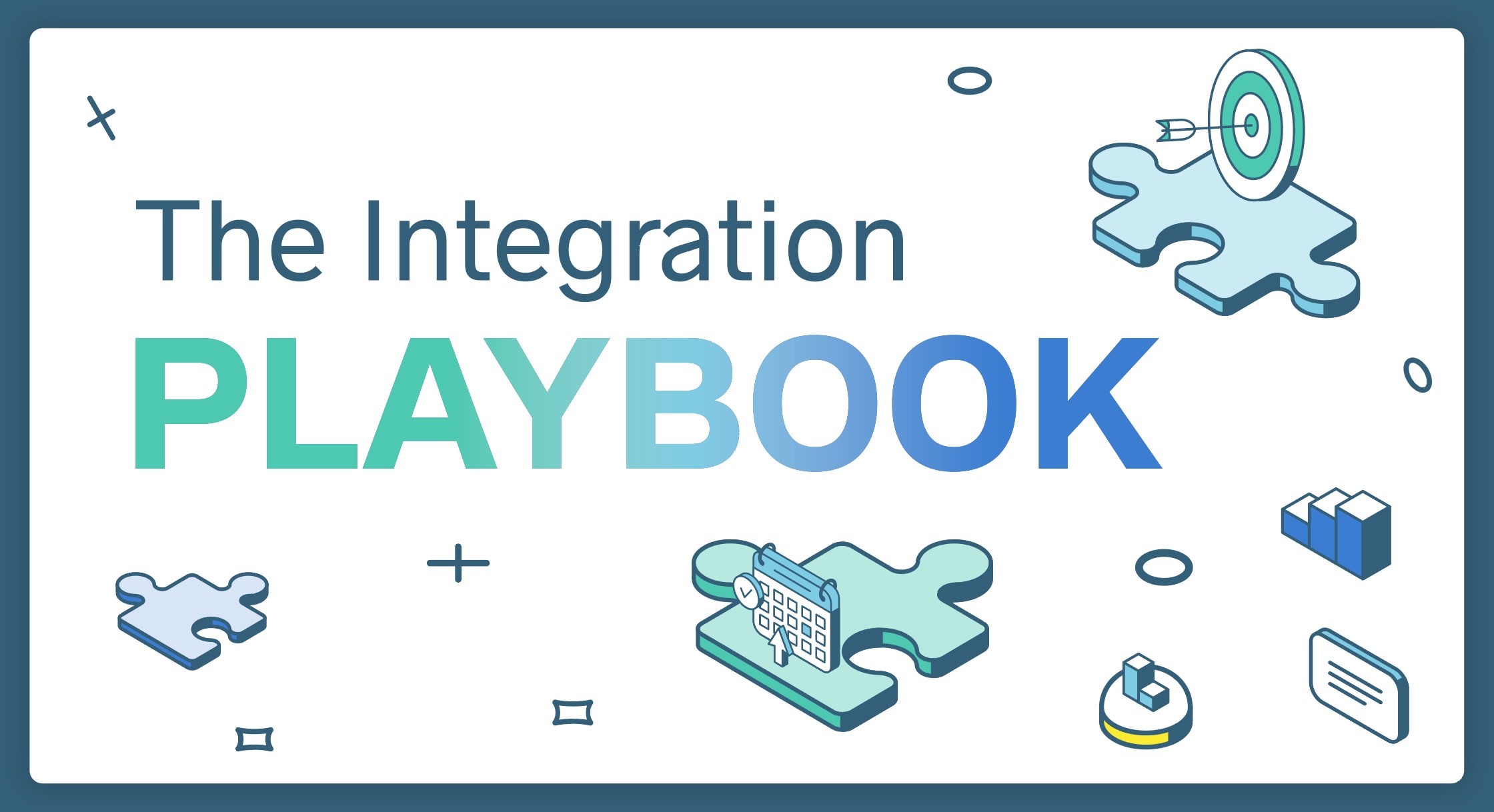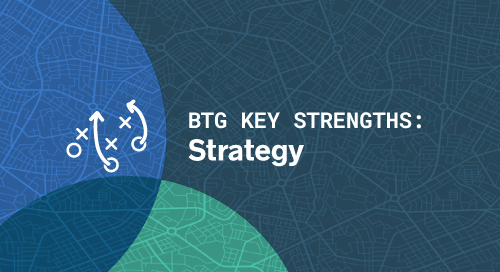No matter your line of work, AI is likely making its mark on your industry, and new developments in tech are becoming a daily conversation.
At the organizational level, the ability to keep pace with innovation is an increasingly important performance differentiator, and rewiring the digital ecosystem to allow for continual improvement is a business imperative. The rewards of getting digital transformation right can be abundant and tangible: enhanced cybersecurity, streamlined operations, more actionable data, increased customer engagement—and at the end of the day: competitive advantage.
But getting it right is no simple task. Approximately 90% of companies have launched some kind of large-scale digital transformation. Yet they have captured only a third of the expected revenue lift and 25% of expected cost savings from the effort, according to McKinsey.
Why the results gap? Digital transformations are complex and require a wide variety of skills and expertise across the process—from the initial vision and strategy through implementation, culture change, and scale. There’s a lot of room for error. One key differentiator between success and failure McKinsey identifies: executive-level talent.
Companies are increasingly engaging on-demand transformation leaders to provide niche knowledge, strategic insights, and experienced oversight to accelerate progress from one phase to the next. In fact, BTG’s 2025 High-End Independent Talent Report found that demand for experts in AI and machine learning grew 46% YOY; requests for interim leaders overall have skyrocketed 310% since 2020, with a 20% increase in demand for interim CIOs, CTOs, and CISOs in particular.
From change managers, project managers, and interim executives to experts with digital skills like data and analytics, AI, or machine learning, experienced digital transformation leaders are available on demand to offer high-level advice, integrate with internal teams, or drive and manage workstreams.
On-Demand Talent for Every Phase of a Digital Transformation
Each stage of a transformation relies on the groundwork established in the previous phases. A meticulous approach ensures that strategic planning, stakeholder involvement, and implementation build upon each other, reducing risks, making the best use of resources, and increasing the chance of reaching the end goals. Let’s look at how companies engage on-demand talent across a holistic digital transformation.
1. Envision: Defining Success
Decisions made in the first phase of a digital transformation will cascade throughout the rest of the initiative and have lasting implications on the company’s ability to capture evolving tech opportunities down the line.
In this phase, the purpose and objectives must be clearly defined. Typically there are multiple end goals such as enabling AI decision-making tools that both enhance the customer experience and improve operational efficiency, for example. Stakeholders, including company leaders, employees, and customers, are engaged to communicate the vision and gather input on priorities and desired outcomes. Independent strategists frequently support these activities by helping to align goals and objectives, streamline communication, and foster transparency.
Current and future state assessments are critical in this phase. This includes a detailed examination of the organization’s existing digital capabilities—including infrastructure, systems, and processes—to identify strengths, weaknesses, and opportunities. From there, the desired future state of the organization’s digital ecosystem can be mapped out, informed by emerging technologies, industry trends, and competitive dynamics. Independent consultants are often brought in for projects such as:
- Conducting systems and process evaluations
- Identifying areas for improvement
- Providing an outside perspective on best practices and suitable technologies
- Performing risk assessments
- Evaluating security vulnerabilities
- Providing data and analytics expertise to bolster a strong data foundation
In one recent example, the emerging technology group of a major life insurance company was in the first stage of an AI transformation aimed at improving efficiency. The team was struggling to identify the tools, processes, and business areas to prioritize. BTG provided a former AT Kearney partner and disruptive technology executive to assess the current state, get buy-in, and develop the go-forward AI vision.
2. Plan: Developing a Comprehensive Transformation Strategy
The second stage of a digital transformation layers on the strategy and resource allocation necessary to achieve the phase one vision. This includes detailing the approach, priorities, and roadmap, as well as the budget, talent, and technology investments necessary to support the implementation and transition. A crucial step in this phase is the design of a scalable and flexible technology architecture that supports the organization’s digital objectives.
Independent experts and transformation leaders can be an asset here—stepping in to provide strategic insights as well as niche tech knowledge to inform critical decisions and next steps. For example, when a global financial services firm was transforming its IT operating model with overarching goals of increasing efficiency, building a stronger data foundation, and enabling cloud technology, the leadership team needed an experienced and objective view of what could be done differently. Through BTG, they sourced a senior IT transformation expert who had trained at McKinsey and served as CIO at several major companies. After analyzing the team’s topline business imperatives and long-term aspirations, the consultant refined the IT operating models based on the company’s internal drivers, leveraging best practices to draft a high-level framework for the future.
Another phase two priority is creation of a change management plan that addresses cultural shifts, skill gaps, and organizational readiness for adopting the new digital technologies. Change management is key to maximizing the effectiveness of any transformation, and independent change managers can provide a fresh, unbiased perspective and specialized expertise to ensure all the integral pieces are put into place. This might entail facilitating communication, tracking KPIs, or collecting feedback and making adjustments.
3. Implement: Executing the Digital Transformation Plan
In the third phase, strategic plans and designs are executed, and the organization begins the transition to new systems and processes. Technology deployment might span multiple fronts, such as enterprise software, mobile apps, IoT devices, and AI solutions—a web of processes that requires skilled leadership and hands-on expertise across multiple teams and departments.
Change management continues to be integral to ensuring success and maintaining momentum. In addition to on-demand change managers, independent talent are often engaged to provide program and project management for specific workstreams, enabling multiple facets of the transformation to run in tandem with one another.
Take the case of one retailer in the midst of a major transformation to digitize its end-to-end design and manufacturing process. In need of help keeping the project on track, the innovation team brought in an independent program manager to drive project streams for technology and supply chain, prepare content for governance reviews, and make sure all milestones were met.
In this phase, hands-on roles that require specialized skills, such as machine learning, large language models, and advanced analytics, are incredibly important, and those skills can be difficult to source in-house. In fact, a 2023 survey by BTG found that more than one-third of executives anticipate expertise limitations in data and analytics; compliance, reporting, and risk management; and process improvement and business transformation. Independent experts offer fast and flexible access to such skills and can also step in to provide training and development to equip in-house teams with the necessary digital skills and capabilities to succeed in the organization’s new digital environment.
4. Scale and Sustain: Fostering a Culture of Innovation
The technology has been deployed, new processes are in place, and most employees have been trained, but the transformation isn’t complete. This final phase focuses on evaluating, optimizing, and leveraging lessons learned from pilot projects, as well as documenting the progress and developing in-house champions to encourage adoption and ensure long-term success.
On-demand talent is often a source of bandwidth and expertise for activities such as developing continuous improvement mechanisms, implementing robust cybersecurity measures, and establishing risk management practices to protect digital assets and data, ensuring the resilience and sustainability of the digital transformation efforts.
A critical component of the final phase of a digital transformation is fostering a culture of innovation—encouraging employees to explore new ideas, technologies, and business models that drive digital innovation and differentiation. On-demand talent can be brought in to provide objective feedback, inject new ideas, and serve as mentors and coaches for internal teams.
In one instance, the global procurement team of a multinational life science team was nearing the end of a major transformation to implement a new cloud-based procurement system, which was going to require the team to adopt an entirely new way of working. The head of strategic project delivery worked with BTG to engage a former senior consultant at PwC and IBM to collaborate closely with content and process owners to determine training needs and then develop a curriculum to support the company’s change initiative.
If done well, a digital transformation can act as a force multiplier, allowing companies to achieve multiple strategic objectives through a single investment: adopting tech that improves both the customer and employee experience, for example, or creating efficiencies that both reduce costs and enhance security.
Support Your Talent with a Rigorous Execution Framework
You have the right experts in place to drive digital innovation, but does your organization have the structure to support them? Sustained progress requires more than just specialized skills; it demands a system that keeps daily operations running while you build for the future. Our new guide, The Transformation Playbook, provides the practical checklists and worksheets you need to organize workstreams, address friction, and ensure your digital investments deliver lasting impact.
Five Benefits of Bringing in On-Demand Talent to Support and Accelerate a Digital Transformation
- Access to Specialized Expertise: Many of the specialized skills and expertise necessary to get it right may not be readily available within the organization. Engaging independent experts allows transformation leaders to access talent that is often hard to find in the full-time market.
- Flexibility and Scalability: Transformation workstreams are inherently temporary. Bringing in external talent provides flexibility in terms of engagement duration and scope of work. Business leaders can scale resources up or down based on project needs, allowing for efficient resource allocation.
- Cost Reduction: Hiring on-demand talent for short-term engagements is a cost-effective way to support projects that require expertise for a limited period of time and can also function as an alternative to or follow-on from a large consulting firm.
- Objective Perspective: External consultants and specialists bring a fresh perspective to the transformation process, free from internal biases or constraints and rich with outside knowledge and broad industry insight.
- Augmentation of Internal Resources: On-demand talent can complement internal teams by filling skill gaps or providing additional capacity during peak periods of transformation activity, as well as serve as mentors or interim leaders for in-house teams.
A successful digital transformation establishes a technical and operational foundation that can withstand disruption, new tech, market fluctuations, and changing customer demands. Harnessing the power of on-demand talent throughout the course of a digital transformation can help achieve sustained success in driving meaningful and lasting change. Reach out today to find talent to support your digital transformation.
GET THE SKILLS YOU NEED
Thousands of independent consultants, subject matter experts, project managers, and interim executives are ready to help address your biggest business opportunities.













